Standing on Bitton Road, Teignmouth is Bitton House, used as council offices was once the home of Admiral Pellow, Lord Viscount of Exmouth,
WEST TEIGNMOUTH is divided from [East Teignmouth] only by a small brook, and contains 403 acres of land, and increased its inhabitants from 1528 in 1801, to 2883 in 1841. The Earl of Devon is lord of the manor of East Teignmouth, and Lord Clifford of West Teignmouth, the former of which was long held by the Dean and Chapter of Exeter, and the latter by the Bishops of Exeter.
West Teignmouth was a celebrated haven for ships at an early period, the river being then navigable for large ships, and having no shifting bar at the entrance.
Bitton House, Gem of Teignmouth’s Residences (Contributed by the Teignmouth Historical Society)
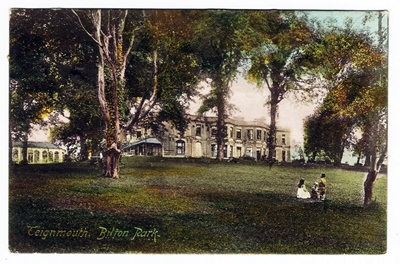
On the north bank of the Teign on a grass covered knoll overlooking the busy little harbour and the last big bend of the river before it sweeps into the sea below the Ness, is Teignmouth’s foremost building, Bitton House.
For many years the home of financial moguls of their day the Praed family, a famous Admiral – a contemporary of Nelson – then the residence of a distinguished and well-known poet, Bitton House has a charm and a history all it’s own.
The Bitton Estate – in the very early days, around the 13th century was the property of Bishops Bronescombe (1258) and Bitton (1292) and extended along the river front, from a point near the end of the Shaldon Bridge to the site of the Old Quay covering 18 acres. In those days it was a rolling park land of grass and trees and mainly evergreen Ilex Oak. The poet who later lived in this lovely house described it in one of his poems as :-
There beamed upon the riverside
A shady dwelling-place
Most beautiful. Upon that spot
Beside the echoing wave
A fair might have built her grot
An anchorite his grave.
In the early 18th century the first Bitton House (later known as Bitton Manor) stood on the side of the present rugby football ground and the parkland stretched eastwards towards the Old Quay. The first erected Bitton House stood on the lower area known as the rugby football ground and was later known as Bitton Manor.
Whilst Haunted Devon researched the various residents, they noticed that Bitton House has also been referred to as West Cliff house, Westbrook House, Bitton Grove and Bitton Court.
The Mackworth Praed Family
William Mackworth Praed
William Mackworth Praed married Susannah Stokes 1727-1794. Praed who had banking interests in London, founded the first bank to open in the city of Exeter, The Exeter Bank on the 9th July 1769 along with his partners; John Duntze, Joseph Sanders and Daniel Hamilton
Pread designed and built the buildings for the Exeter Bank, the Assembly Rooms and the hotel in 1769. The Assembly Rooms was erected in a Georgian style–the entrance was on the left of the building, with a columned porch and pitched roof, and a similar coach entrance on the right. He added two extra floors, and the arrangement of the windows, with a large gap in the middle suggesting that should the hotel have failed, his investment would be safe and easily converted into two houses
The viability of the Assembly Rooms must have been in question, for on the 7 September 1770, an advert was placed by Pierre Berlon, the French proprietor using the word hôtel for the first time in England. Jenkin's 1806 History of Exeter described the hotel thus:
"The only house, worthy of notice in its parish is, The Hotel, a large commodious Inn, with elegant apartments and Hotel accommodation for people of the first quality, with a large assembly room in which assize balls, concerts and assemblies of the most distinguished persons of City and Country take place, in the front is a neat coffee room. The situation of 'The Hotel' is very pleasant as it opens to the parade and commands a noble view of the Cathedral."
The hotel became The Royal Clarence Hotel. Praed also held leases on tenements near the Cathedral, and land in St David's, before he took a lease on the site in 1766.
William leased Bitton House, which was to be the Mackworth Praed country estate and where he and Susannah would raise a family. They had six children;
William Mackworth Praed born 3rd March 1756-1835, married Elizabeth Winthrop on 1st April 1795.
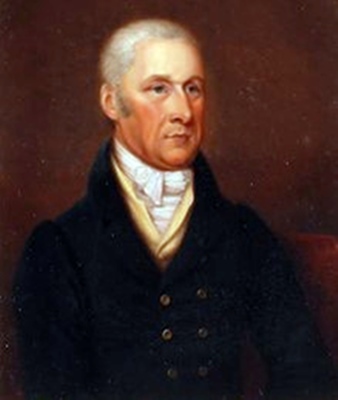
William Serjeant Mackworth Praed 1756 to 1835
Juliana Mackworth Praed, 1757- 1841 born at Bitton House. She married Thomas Smith and, on his death, married 17th February 1822 Thomas-William Shore in holy orders, vicar of Sandal, Co. York.
Susannah Mackworth Praed, 1760 born at Bitton House died 13 October 1856. Married Thomas Smith, 'apparently a Jamaican plantation and slave owner'.
Arrabella Mackworth Praed, (twin of Susannah) 1760-1843, born at Bitton House, She was Lady-in-Waiting to Queen Adelaide and on 24 May 1792 married John Bourke, 4th Earl of Mayo, GCH, PC (Ire) (18 June 1766 – 23 May 1849) was an Irish peer and courtier, styled Lord Naas from 1792 until 1794. After her marriage, Arabella Mackworth-Praed was styled as Countess of Mayo on 20 August 1794.
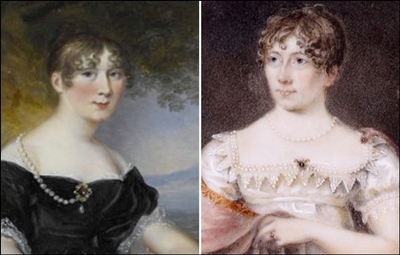
The twins. Above left; Susannah Smith (Née Mackworth-Praed), seated in a landscape, wearing black décolleté dress with white lace trim. Artist James Leakey (British, 1773–1865), and right: Arabella Bourke (English School,

Watercolour of Vice Admiral Bulkeley Mackworth-Praed, commanded HMS Crash in 1797 attributed to Walter Stephens Lethbridge (1771-1831.
Bulkeley Mackworth Praed, 1770-1852. Born at Bitton House. entered the navy on 21st September 1780, as a first-class volunteer on board the “Canada”. With a glowing career in the navy, he was promoted to Vice-Admiral of the White in 1846 and in 1850 was made Vice-Admiral of the Red. Bulkeley Mackworth-Praed died on 15th October 1852 at his seat, Acton Castle, Nr. Marazion, Cornwall.
Phineas Mackworth Praed, 1772, born at Bitton House. After William Mackworth Praeds death in 1791, his following descendants continued in the family financial business Praeds and Co., bankers, of Fleet-street, London.
His eldest son, William Mackworth Praed 1756-1835, became a serjeant-at-law: commonly known simply as a Serjeant, was a member of an order of barristers at the English bar and revising barrister for Bath and chairman of the Audit Office .
Later, having met the daughter of Benjamin Winthrop, Governor of the Bank of England, Elizabeth Winthrop 1768-1810, after a period of engagement the couple wed in 1795.
William Mackworth-Praed and Elizabeth Winthrop had four children:
Bulkeley John Mackworth Praed (born 2 August 1799 in Devon; died 12 March 1876 in Ousden Hall, Suffolk) was an English first-class cricketer associated with Marylebone Cricket Club (MCC) who was active in the 1820s. Bulkeley John Mackworth-Praed was married three times:
- Emma Dick (d. 3 August 1836) on 22 December 1828
- Elizabeth Colthurst FitzPatrick (d. 6 February 1852), on 14 July 1840 to with whom he fathered:
- Emily Maria Fane (d. 11 May 1905) on 26 April 1859
William Mackworth-Praed, born 1797 – died 1857. In 1831 married Ann Frances Hayes born in Delamore Ivybridge Devon, at age 33. William passed away in 1857, at age 60. They had one daughter:
- Ann Elizabeth Parker (born Mackworth-Praed).
Susan Mackworth-Praed, born, c 1805 – died, 20 May 1895. On 23 June 1835, married George Young August 2nd Barone Elizabeth Susan Young2 d. 11 Oct 1925
- Sir George Young, 3rd Bt. (b. 15 Sep 1837, d. 4 Jul 1930)
- Reverend Edward Mallet Young (b. 24 Jan 1839, d. 19 Dec 1900)
- Sir William Mackworth Young (b. 15 Aug 1840, d. 10 May 1924)
- Albert Stewart Winthrop Young (b. 16 Mar 1842, d. Feb 1918)
- Bulkley Samuel Young (b. 2 Dec 1843, d. 23 Aug 1866)
Winthrop Mackworth-Praed. Born in London, 26 Jul 1802 – died, 15 Jul 1839. He married Helen Mackworth-Praed in 1835. They had two daughters:
- Helen Adeline White
- Elizabeth Lillian Mackworth-Praed.
Winthorp died of tuberculosis at Chester Square, London
William Mackworth Praed, Sergeant-in-Law: and his wife Elizabeth were laid to rest in the family tomb at St James.
Lord viscount of Exmouth. Admiral Edward Pellew And Family.
Admiral Edward Pellew
Edward Pellew derived from a Cornish family, whose descendants came originally from Normandy, but had for many centuries been settled in the west of Cornwall.
Aged 14, Edward ran away feeling the pull of the sea, but soon deserted because of unfair treatment he witnessed to another midshipman. In 1775 he secured a position on the 32-gun frigate, Blonde, under the command of Captain Philemon Pownoll who came from a nautical background, had the reputation of being a fine seaman and was wealthy through privateering activities.
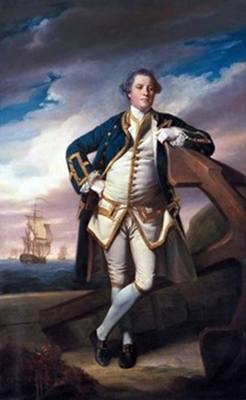
Captain Philemon Pownoll, officer of the Royal Navy painted by Plymouth born artist Joshua Reynolds.
Blonde crewed by 220 men, sailed for North America on 7th April 1776. During the voyage Burgoyne was alarmed to see a midshipman on a yardarm balancing on his head. Pownoll reassured him that it was just one of Pellew's antics, and that 'should [he] fall, he would only go under the ship's hull and come up on the other side. Later in the voyage Pellew jumped overboard to save a man's life, and was reprimanded for his actions by Pownoll, though he later shed tears when talking about it with his fellow officers and called Pellew 'a noble fellow.Pellew and Pownoll served at the relief of Quebec. Pellew fought at the Battle of Lake Champlain on 11 December 1776 under the command of Lieutenant James Richard Dacres, and when injury befell his superior he found himself in command of the schooner Carleton 12, earning instant acclaim in the service for setting the jib of his vessel under a heavy fire, and in bringing the Carleton to safety. April 1780 he was appointed senior lieutenant of the Apollo 32, once more serving under his friend and mentor Captain Pownall. On 15 June 1780 he assumed command of the frigate when After nearly an hour of intense cannonading Pownoll was hit by a cannon ball and killed during an engagement with the French privateer Stanislaus 26 off Ostend, an engagement Pellew won by driving the enemy ashore.
Captains Pownoll's death was widely mourned, Pellew writing in his report to the Admiralty that:
'The loss of Captain Pownoll will be severely felt. The ship's company have lost a father. I have lost much more, a father and a friend united; and that friend my only one on earth. Never, my lord, was grief more poignant than that we all feel for an adored commander. Mine is inexpressible.
In tribute to his friend’s memory Pellew named his eldest son Pownoll Bastard Pellew in honour of his former captain and Pownoll's grandson, John Bastard.
Edward’s career languished and he was forced to accept a landlubber’s life and tried farming at a property owned by his brother who was a senior customs officer of Flushing, Treverry Farm near Helston. This proved not to be his forte and was met with indifferent success as during this period he attempted to sell a bull, only to discover that it belonged to a neighbouring farmer.
It was at this time when he met Susanna “Susan” Frowde in 1782, she was born in East Knoyle in Wiltshire in 1756, the daughter of James Frowde Esq., a local gentleman. The couple married on 28 May 1783 when she was aged eighteen and Edward was twenty-six.
The Russians offered Pellew a command in the Russian navy, but it was an offer he politely declined. While he struggled to get to grips with the difficulties of the farm when on 1 February 1793 the revolutionary government of France declared war on Great Britain.
He was also a good swimmer and noted for saving many lives. The most striking event was on January 26, 1796 when the East Indiaman Dutton, which was carrying troops, ran aground under Plymouth Hoe. Due to the heavy seas, the crew and soldiers aboard were unable to get to shore. Pellew swam out to the wreck with a line and helped rig a lifeline which saved almost all aboard. For this feat he was, on 18 March 1796 created a baronet
Edward and Susan had four sons and two daughters:
Emma Mary Pellew (18 January 1785 – March 1835) married 7 Sept. 1803, Mylor, Cornwall, Admiral Sir Lawrence William HALSTED, G.C.B. (2 April 1764, Gosport - 22 April 1841, Stoke Damerel), and became Lady Emma Mary Halstead. She died aged 50 and was buried in Christow. They had eleven children;
- Emma Mary Halsted was born on 13 October 1804 in Stanstead, Essex. She married George Martin BRAUNE on 27 October 1834 in Tor-Moham, Devon.
- William Anthony Halsted was born on 20 November 1805 in Plymouth, Devon. He married Georgina Susan HONEY on 1 October 1836 in Madras, Bangalore. He died on 11 September 1867 and was a Colonel in the Army.
- Edward Pellow Halsted was born on 28 December 1807 in East Teignmouth, Devon. He was a Vice-Admiral and died on 17 July 1873 in Haslar, Hampshire.
- Susan Amelia Halsted was born on 13 November 1809 in Gosport, Hampshire and married Richard Maxwell FOX on 14 September 1835 in Greenwich, Kent.lia Pellew HALSTED was born on 19 August 1811 in Shaldon, Hampshire and married Richard HARWARD in August 1834 in Scotland.
- Louisa Caroline Halsted was born on 22 October 1813 in Alton, Hampshire.
- Elizabeth Hamilton Halsted was born on 24 October 1814 in Alton. She died on 3 December 1903 in Claygate, Surrey.
- Charles Frankland Fleetwood Halsted was born on 13 October 1817 in Alton.
- Lawrence George Halsted was born on 17 August 1820 in Alton. He died on 7 November 1846 in the Far East.
- Jane Plumer Halsted was born on 20 July 1822 in Alton and died on 12 March 1891 in Pinner, Middlesex.
- Mary Anne Halsted was born in 1829 in Paris, France. She married William CRAWFORD on 29 December 1853 in Melbourne, NSW, Australia
Pownoll Bastard Pellew, later 2nd Viscount Exmouth (1 July 1786 – 2 December 1833) a Captain in the Royal Navy, and Naval Aid-de-camp to the King; On 1 October 1808, he married Eliza Harriet Barlow, (1789 -1833). eldest daughter of Sir George Barlow, 1st Baronet, the Governor of Madras, and started building the new family seat of Canonteign in Devon but the couple divorced in 1820. They had two sons and one daughter.
- Edward Pellew (14 February 1811 – 11 February 1876); he would become the 3rd Viscount Exmouth.
- Percy Taylor Pellew (15 April 1814 – 31 December 1848); officer in Madras Cavalry.
- Juliana Sarah Pellew (16 June 1816 – 31 August 1891)
On 15 April 1822, he married Georgina Janet Dick, eldest daughter of Mungo Dick, Esq. She was born circa 1800 and died 15 February 1870.[2] They had three sons and two daughters:
- Pownoll Fleetwood Pellew (26 July 1823 – 25 December 1851); lieutenant in the Royal Navy.
- Caroline Emma Pellew (24 February 1825 – 2 March 1832)
- a daughter (September 1827; died in infancy)
- Fleetwood John Pellew (6 November 1830 – 2 August 1866), father of the 4th Viscount.
- Barrington Reynolds Pellew (18 April 1833 – 6 December 1858); major in the 2nd Battalion, Rifle Brigade.
Julia Pellew (28th November 1787 –26th December 1831) Julia married Richard Harward on 11 January 1810 at St Charles the Martyr, Plymouth, Devon, England. She died on 26 December 1831 at Maisemore Lodge, Gloucester, Gloucestershire, England.
Fleetwood Broughton Reynolds Pellew, later an admiral and knight (13 December 1789 – 28 July 1861) a Captain R.N.; he married in 1816 Harriet Webster, only daughter of the late Sir Godfrey Webster, Bart., by Elizabeth, now Lady Holland. Harriet died in 1849, and Fleetwood married Cecile Drummond de Melfort in 1851, but the two divorced in 1859. Sir Fleetwood Pellew died at Marseilles on 28 July 1861 at the age of 71,he is buried with his first wife, Harriet née Webster, in the English Cemetery, Florence.
- Thomas Chaplin (1818–1819), who died in infancy.
- Harriet Bettina Frances (1820–1886), who married Lord Horatio Walpole in 1841, thus becoming Lady Walpole, and eventually Countess of Orford, when her husband succeeded to the Earldom of Orford in 1858. She died in November 1886. Lord Orford survived her by eight years and died in December 1894, aged 81
George Pellew, (3 April 1793 – 13 October 1866) Dean of Norwich, and a Prebendary of York; he married in 1820 the Hon. Frances Addington, second daughter of Lord Viscount Sidmouth, and had four daughters;
- Frances Ursula Pellew (10th March 1821 - 17th February 1840)
- Georgiana Susan Pellew (1830-2 Jan 1896)
- Charlotte Augusta Pellew (1813. 21 May 1866)
- Henrietta Agneta Pellew (1838 - 17 Dec 1920)
- Marian Hilary Adelaide Pellew (1832-. 22 Dec 1901)
- Henry Edward Pellew, 6th Viscount Exmouth (26 Apr 1828, d. 4 Feb 1923)
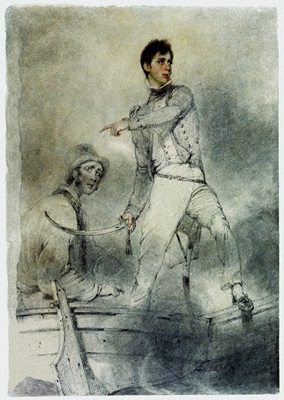
Captain Fleetwood Pellew commanding H.M. Ship Terpsichore against Dutch vessels in Batavia Roads 24 Nov. 1806. Drawn at Madras, May 1807 by George Chinnery.
Edward William Pellew (3 November 1799 – 29 August 1869), became a minister. He married Marianne Winthrop, daughter of Stephen Winthrop, on 10 April 1826. He died on 29 August 1869 at age 69. Children of Reverend Edward Pellew and Marianne Winthrop:
- Emma Susan Pellew (d. 6 Sep 1909)
- Elizabeth Julia Pellew (d. 16 Jul 1890)
- Frances Helen Pellew (d. 7 May 1917)
- Georgina Caroline Pellew (d. 23 Apr 1940)
- Mary Anne Pellew (b. 1828 - d. 1910)
- Commander Pownoll William Pellew b. 27 Jan 1837, d. 12 Mar 1872
- Fleetwood Hugo Pellew b. 13 Dec 1838, d. 24 May 1906.
Susan was a devoted wife who supported her husband's naval career, managed their estate and raised their family during his absences at sea; however, she vehemently opposed his political ambitions and when he was appointed MP for Barnstaple in 1802, she refused to accompany him to London.
During the Napoleonic Wars there were over several naval officers made their home in Teignmouth or nearby, attracted by the activities of the harbour in which many of them shared. One was Sir Edward Pellew when in 1812 his wife Susan purchased two new properties for the family: Canonteign House which was deemed unsuitable by the Admiral on his return from sea and was passed to their eldest son Pownoll lived with his wife Eliza, having built a suitable fashionable property, and West Cliffe House (now Bitton House) with the intention to make his home after his retirement for his family and all 22 grandchildren who came and went on a regular basis. Shortly after he became Commander-in-Chief of the Mediterranean, and Vice-Admiral of the United Kingdom.
Being a man of religious convictions being aware that the original structure of nearby St James was in a near derelict condition Admiral Sir Edward Pellew commissioned a new building. The unusual octagonal plan of the nave may have been a reminder of his glorious victory over the Said of Algiers when he released over 1200 Christian slaves from captivity. Sir Edward was a great friend of Thomas Luny, the marine artist, who lived and worked in Teignmouth, and whose house is within clear sight of St James'. It is said the Sir Edward's design of the church is reminiscent of port buildings at Algiers/
In 1816, a squadron under Admiral Sir Edward Pellew was fitted out and sent to Algiers where they arrived, in company with a small Dutch squadron, on 27 August 1816. They sought the release of the British Consul, who had been detained, and over 1000 Christian slaves, many being seamen taken by the Algerines. When they received no reply the fleet bombarded Algiers in the most spectacular of several similar punitive actions of this period that finally broke the power of the 'Barbary pirates', who had been a plague on European commerce in the Mediterranean for centuries.
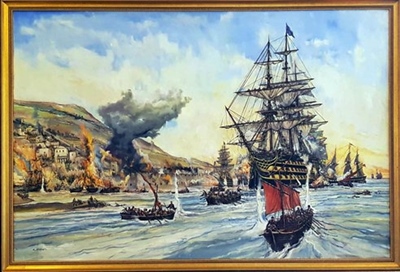
Painting depicting the Bombardment of Algiers which hangs in Bitton House.
Pellew was subsequently created Viscount Exmouth. It proved a vital blow to the cruel trading in slaves in the Mediterranean. The day of his Lordship's return was made a local festival day. The inhabitants turned out to greet him "with all the arrangements and display which could manifest admiration and attachment". After when he informed the admiralty that he had finally ‘struck his flag’ and was rewarded with the title of Viscount. Two canons (the gift to the town by Morgan Giles who re-built them) stand at the rear of Bitton House, souvenirs of his Algerian campaign, and a window in the house still has the Exmouth Arms with supporters all in beautiful colour.
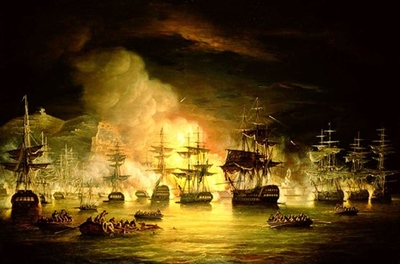
Painting of the Bombardment of Algiers by Admiral Pellews close friend and local artist, Thomas Luny.
Remarkable also the memorial, records lines from a poem written to commemorate:
"Lord Exmouth's humane and magnanimous conduct, when, at the imminent risk of his life, he rescued (under the blessing of Divine Providence) near five hundred souls, men, women and children, many of whom were sick, from the wreck of the 'Dutton' East Indiaman, in a tremendous storm, January 26th 1796".
The poem, written by a spectator of the event, was recited at a public dinner given by the Corporation of Plymouth to honour the hero. The event is also recorded in a painting in the Plymouth Museum. Sir Edward Pellew and his wife were in their carriage on their way to dine with the Vicar of Charles, when they saw that the "Dutton", driven into Plymouth Sound by the storm, was in difficulties. He managed to get aboard, though in doing so injured his back. Taking charge, he ensured that all on board, over 500 souls, including women and children were saved. For this action he was created 1st Viscount Exmouth on 10 December 1816. Following his return to England he became Port Admiral at Plymouth from 1817 to 1820, when he effectively retired from active service. He continued to attend and speak in the House of Lords. In 1832 he was appointed Vice-Admiral of the United Kingdom.
Pellew had a remarkably successful naval career and awarded numerous titles including that of Viscount Exmouth. He entered politics and became MP for Barnstaple, attending the House of Lords regularly. In 1833, Sir Edward Pellew passed away peacefully in his home
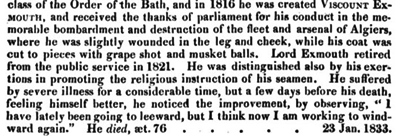
Excerpt taken from Sharpes Peerage of the British Empire vol 1
A large and powerful man Sir Edwards, brilliant seamanship, determination backed by a fiery temper and heroics were all highly esteemed Pellew, who had lost his own father at an early age and was a devoted, if over indulgent, father to his own children, also took great pride in acting in loco parentis to the young gentlemen under his command. It is striking how many of his men identified Pellew as a father figure, and in letters of condolence following his death, many referred to him as both father and friend. In a moving condolence letter, James Weymss, who served with
Pellew in India when he was a young lieutenant, referred to the admiral as “my father afloat”.
His funeral service were described in the book "The Annual Biography and Obituary: 1834, Volume XVIII, London, 1834 (no author given, paragraphing added).
"The funeral of Lord Exmouth took place on the 6th of February at Christow, in which parish the mansion and estate of Canonteign are situated. His Lordship had expressed a wish that his funeral should be conducted with the utmost privacy; but the desire to show respect to this brave sailor and excellent nobleman was so strong that a very numerous cortege, composed of the carriages of the neighbouring nobility and gentry, attended.
"The flags at Teignmouth on board the ships, and on all the flag-staffs, were struck half-mast, the shops were closed, and every possible demonstration of respect was exhibited. The British ensign, under which his Lordship had served and fought in every quarter of the globe, was used in lieu of a pall; and on the coffin was placed the flag (blue at the main) which flew at the mast head of the Queen Charlotte during the arduous conflict at Algiers; several shots had passed through this honourable emblem of the departed nobleman's great achievement; the sword his Lordship wore on that occasion, hung with crape, was also placed on the coffin.
"His Lordship's four sons, his son-in-law Captain Harwood, and other near relations of his family, attended on the occasion, as did also Vice-Admiral Sir Charles Ekins, Captain the Hon. T. W. Aylmer, and Captain Parson, all of whom served under his Lordship at Algiers; Rear-Admiral Sir Charles Dashwood, Captain Bastard, Captain Hill, Captain Reynolds, and other of the Royal Navy; Mr. Bentinck, Rev. Mr. Carrington, Mr. Munro, Mr. Chichester, and many other gentlemen. On the conclusion of the solemnity, a young oak tree was planted, and named the Exmouth Oak, opposite the door of the vault."
On the 30th January 1833 he was buried in the village church, Christow for which he was largely responsible for the rebuilding of during his retirement. A note on the parish burial record states, “no singing, no sermon”.
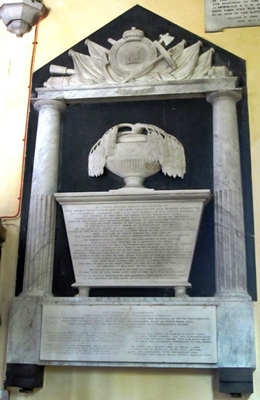
Sir Admairal Edward Pelles vault and final resting place.
The inscription reads:
In a vault beneath repose the remains of
The Right Hon. EDWARD PELLEW, Viscount and Baron EXMOUTH,
of Canonteign, a Baronet, and LL.D. Vice-Admiral of the United Kingdom,
and Admiral of the Red Squadron of His Majesty's Fleet,
Knight Grand Cross of the Most Honourable Military Order of the Bath,
also of the Royal and distinguished Order of Charles the Third of Spain,
Of the Military Order of William of the Netherlands,
Of the Royal Sicilian Order of St. Ferdinand and Merit,
Of the Military Order of St. Maurice and St. Lazare of Sardinia, and
Knight of the Most Honourable and Most Ancient Order of the Annunciation
of the Royal House of Savoy,
High Steward of Great Yarmouth, and one of
the Elder Brethren of the Hon. Corporation of the Trinity House.
_____
His eminent public services are recorded in the annals
and live in the memory of a grateful country.
This private and more humble monument records his Christian virtues:
His active benevolence, which often risked his life to
rescue fellow-creatures from the deep, and to break the chains of
Christian brethren, mourning in helpless captivity in a heathen land.
All human glory ceases in the grave: but far dearer is the memory of
that devout faith which led him in deep humility to the cross of Christ,
the star which guided him to his desired haven,
the anchor of his hope, when, on the death-bed of the just,
he yielded up his soul to his Redeemer.
He departed in peace, on the 23rd day of January,
in the year of our Lord 1833, and in the 76th year of his age.
This monument is erected by his grateful and affectionate family,
to the memory of the best of husbands and of parents.
_________
Lines written to commemorate
LORD EXMOUTH'S humane and magnanimous conduct,
when, at the imminent risk of his life, he rescued, (under the blessing of
Divine Providence)
near five hundred souls - men, woman, and children, many of whom were sick,
from the wreck of the Dutton, East Indiaman, in a tremendous storm,
January 26, 1796.
While o'er the reeling wreck the savage storm
Pour'd all its lightning's, thunders, blasts, and hail;
And every horror in its wildest form
Smote the firm heart, that never knew to fail:
'Twas thine, Pellew, sublimely great and good!
For man, thy brother man, distress'd, to dare
The dreadful passage of the raging flood,
And join the frantic children of despair.
There it was thine, in comfort's balmy tone,
To soothe their sorrows 'mid the tempest's roar;
To hush the mother's shriek - the sick man's groan,
And bear the suff'rers trembling to the shore.
So when this mighty orb, in dread alarm,
Shall crash in ruins, at its God's decree;
May thy Redeemer, with triumphant arm,
From the vast wreck of all things - rescue thee.
Susan disapproved of the posthumous biography of Pellew, commissioned by his brother Samuel and written by Edward Osler, and she burned the majority of her husband's personal correspondence. The Dowager Lady Exmouth had been indisposed for the last year and died on 29 October 1837 at the age of 81, four years after her husband, and is buried with him at Christow in Devon.
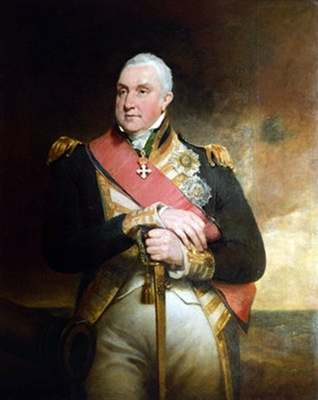
Lord Admiral Edward Pellew, 1st Viscount of Exmouth
As a mark of respect and to commemorate the Admirals career the T.S. Canonteign Sea Cadets (The Teign Valley Unit) traditionally lay a wreath on the family crypt at Christow Church and then take part in a Memorial Service at Canonteign Falls. The current owners of the Falls, Mr and Mrs Christopher Baylis, are keen to keep this tradition alive and to encourage visitors to the Falls to join them in commemorating this brilliant naval man.
In his honour a group of islands, situated in the Gulf of Carpentaria were named The Sir Edward Pellew Group of Islands by Matthew Flinders who visited them in 1802. Other Australian geographical features include Cape Pellew (adjacent to the islands) and Exmouth Gulf. Pellew Island, Jamaica is also named after Edward Pellew. However, while Palau (formerly the Pellew or Pelew Islands), east of the Philippines is often said to be named for Edward Pellew, it was called that by Captain Henry Wilson in 1783 which was well before Pellew came to prominence. It appears to be an anglicization of the indigenous name Belau.
The Admiral will be forever remembered in the town of Teignmouth by the streets and flats named after him by an inspired Council. Sir Edward Pellew, his life and times were the inspiration and immortalised in the highly acclaimed ‘Hornblower’ stories and television series.
The Architect - George Basevi
George Basevi was the youngest son of a City of London merchant, also named George Basevi. The family were of Sephardic Jewish origin. He was educated at the Reverend Dr Burney's school at Greenwich, and then trained professionally with John Soane in 1811, who held him in great esteem, and later went on to spend three years studying in Greece and Rome. In 1821 he became the first surveyor of the Guardian Assurance Company, a post he held until his death.
His designs include the famous Belgrave Square and the classical terraces surrounding it which was built between 1825 and 1841. His other work included the stables at Bretton Hall in Yorkshire, Bywell Bridge in Northumberland, the Entrance Hall and Dining Room at Painswick House for his brother-in-law William Henry Hyett, and the remodelling of Gatcombe Park for the economist David Ricardo. He later designed the remodelling of Bitton Grove, Teignmouth in 1841 for Winthrop Mackworth Praed. Basevi altered and re-cased an existing house and above the middle bay placed a Soanean parapet treatment feature.
One of the architects to be invited to propose plans for the House of Commons reconstruction in 1833. Won the 1835 competition for the Fitzwilliam Museum at Cambridge, one of the principal works of the Early Victorian period. By this time, Basevi was well-established as an English architect
He died on 15 October 1845, aged 51, after falling through an opening in the floor of the old bell chamber of the west tower of Ely Cathedral while inspecting repairs.
Winthrop Mackworth Praed
He was born in London, in the house then occupied by his father, 35 John Street, Bedford Row, on the 26th of July 1802. Bitton House, at Teignmouth was his father's country seat and was regarded as his paternal home. Praed in his writing refers to “two tree that are themselves a wood” and this is believed to refer to the two Elm trees that were planted at the birth of his sisters.
His love for the house and grounds are recorded in these lines: -
“The river with its constant fall
Came close up to the garden wall
As if it longed, but thought a sin,
To look into the charms within.
Behind majestic mountains frowned
And dark, rich groves were all around.
The dark rich groves refer without doubt to the mass of Ilex Oak trees, some of which still remain in the park.
In 1814 Praed was sent to Eton College, where he founded a manuscript periodical called Apis matina. In October 1821 he entered Trinity College, Cambridge, with a high reputation where his career lived up to expectations and was described brilliant. After graduating B.A. in 1825, Praed became private tutor at Eton to Lord Ernest Bruce, younger son of the Marquis of Ailesbury. He won a fellowship at his college in 1827, and in 1830 he won the Seatonian prize-poem. He finally left Eton at the end of 1827. Praed began to study law, and in 1829 was called to the bar at the Middle Temple and on the Norfolk circuit, his prospects of advancement were bright but his passion lay in politics and after a year or two he entered Parliament in 1830 as a Tory. In 1834–35 he was secretary to the Board of Control
His father died in 1835, and in the same summer he married Helen, daughter of George Bogle. Three years later his health, which had never been strong, began to break in 1838 and expectations of a great political future were frustrated by his ill health, and he died of a rapid consumption, at Chester Square, on 15 July 1839 aged just 37. He was buried at Kensal Green. He left two daughters, Helen Adeline Mackworth and Elizabeth Lilian Mackworth. His widow died in 1863.
Praed is best remembered as a writer of witty and ironic light verse in such pieces as “Good Night to the Season” (1827) and “The Belle of the Ball-Room” (1831), though he could combine his comedy with tender insight into human foibles, as in “Our Ball” (1829). He was, in his relations with men, a witty, well-bred gentleman, loyal in love and friend- ship, untiring in the public service, valiant before the world. From his poetry we know him to have been a tender, whimsical soul.
The Belle Of The Ball Room. Poem by Winthrop Mackworth Praed
Years, years ago, ere yet my dreams
Had been of being wise and witty;
Ere I had done wth writing themes,
Or yawn'd o'er this infernal Chitty; --
Years, years ago, while all my joy
Was in my fowling-piece and filly;
In short, while I was yet a boy,
I fell in love with Laura Lily.
I saw her at the County Ball;
There, when the sounds of flute and fiddle
Gave signal sweet in that old hall
Of hands across and down the middle,
Hers was the subtlest spell by far
Of all that set young hearts romancing:
She was our queen, our rose, our star;
And then she danced -- oh, Heaven, her dancing!
Dark was her hair, her hand was white;
Her voice was exquisitely tender;
Her eyes were full of liquid light;
I never saw a waist so slender;
Her every look, her every smile,
Shot right and left a score of arrows;
I though 'twas Venus from her isle,
And wonder'd where she left her sparrows.
Through sunny May, through sultry June,
I loved her with a love eternal;
I spoke her praises to the moon,
I wrote them to the Sunday Journal.
My mother laugh'd; I soon found out
That ancient ladies have no feeling:
My father frown'd, but how should gout
See any happiness in kneeling?
She was the daughter of a dean,
Rich, fat, and rather apoplectic;
She had one brother just thriteen,
Whose color was extremely hectic;
Her grandmother, for many a year
Had fed the parish with her bounty;
Her second cousin was a peer,
And lord-lieutenant of the county.
But titles and the three-per-cents,
And mortgages, and great relations,
And India bonds, and tithes and rents,
Oh! what are they to love's sensations?
Black eyes, fair forehead, clustering locks, --
Such wealth, such honors, Cupid chooses;
He cares as little for the stocks,
As Baron Rothschild for the Muses.
She sketched; the vale, the wood, the beach,
Grew lovelier from her pencil's shading;
She botanized; I envied each
Young blossom in her boudoir fading;
She warbled Händel; it was grand, --
She made the Catalina jealous;
She touch'd the organ; I could stand
For hours and hours to blow the bellows.
She kept an album, too, at home,
Well fill'd with all an album's glories;
Paintings of butterfiles, and Rome,
Patterns for trimming, Persian stories,
Soft songs to Julia's cockatoo,
Fierce odes to Famine and to Slaughter;
And autographs of Prince Lèboo,
And recipes for elder-water.
And she was flatter'd, worshipp'd, bored;
Her steps were watch'd, her dress was noted;
Her poodle-dog was quite adored,
Her saying were extremely quoted.
She laugh'd, and every heart was glad,
As if the taxes were abolish'd;
She frown'd, and every look was sad,
As if the Opera were demolished.
She smil'd on many just for fun, --
I knew that there was nothing in it;
I was the first, the only one
Her heart had thought of for a minute.
I knew it, for she told me so,
In phrase which was divinely moulded;
She wrote a charming hand, and oh,
How sweetly all her notes were folded!
Our love was like most other loves, ---
A little glow, a little shiver,
A rosebud and a pair of gloves,
And 'Fly Not Yet,' upon the river;
Some jealousy of some one's heir,
Some hopes of dying broken-hearted;
A miniature, a lock of hair,
The usual vows -- and then we parted.
We parted -- months and years roll'd by;
We met again four summers after;
Our parting was all sob and sigh --
Our meeting was all mirth and laughter;
For in my heart's most secret cell,
There had been many other lodgers;
And she was not the ball-room's belle,
But only -- Mrs. Something Rogers.
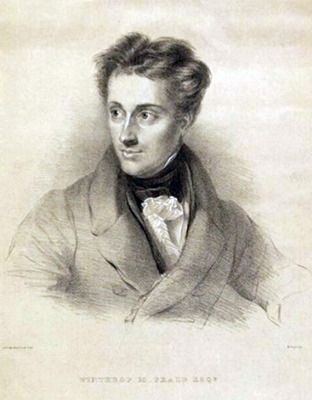
Winthrop Mackworth Praed by Maxim Gauci, printed by Graf & Soret, after Arminius Mayer lithograph, circa 1830s
Further Occupants
Robert Moir
Robert Moir, a landowner and banker, was born c.18O1 in Scotland. His wife, Judith, was a local girl having been born in Kingsteignton c. 1817.
A Teignmouth street directory of 1850 [Museum Collection] records Robert Moir as living at Westcliffe at that time. Possibly, his house “Yannon” was still under construction in 1850, the family moving into their newly built home in early 1851.
The Parson Family At Bitton House 1863- 1899 . A talk given by John Parson to the Friends of the Orangery.
Although I never lived at bitten my talk is based on things my father told main of his life there supplemented by various documents and papers.
The family came to Teignmouth from Launceston because my great grandfathers, Captain John Parson (1785 -1847) was very friendly with the Edward Pillow (later Lord Exmouth) who was Admiral at the Battle of Algiers in 1816. Sir Edward bought Bitton in 1812 and lived there until he died in 1833. Captain John lived in church house adjoining Saint Michael's church although actually died in Jersey.
His son John Parsons a younger as he was known, was born in Launceston in 1815 and died a bit and in 1874 aged 59. He became a solicitor and practiced in the King's Bench Division Court of Chancery Court of Bankruptcy in London being enrolled in 1837. He was also a member of the Institution of Civil Engineers and became very much involved with the early development of the railways
John Parson the younger was a director of the West Midland Railway Company, the Hammersmith and City Railway. Chairman of the Metropolitan Railway the Director of Alexandra Palace. Amongst his other activities he was involved in Saint Luke's Church, Old Street acting as its clerk for many years and laying the foundation stone of a new church hall (I still have the silver trowel which he used) he was also involved with the Dulwich college. In 1860 he was living at Ham. Surrey but where he else he lived I do not know .
He bought Bitton House in 1863 and I was told that in those days the ground stretched from Parson Street by St James's Church to Shaldon Bridge with a high wall along Bitten Street. We have some water colours of the gardens and there was one of the Orangery this seems to have been mislaid unfortunately
John soon became involved in local activities and by the time he died was Chairman of the Teignmouth and Shaldon Bridge Committee and of the Teignmouth Board of Local Government (akin to the Urban District Council). According to records which refer to “the many improvements he made to the town which have been greatly affected through his influence and liberality”, he seems to have done quite a lot. One of his last acts was to give the land for the cemetery on Haldon Road, Teignmouth – ironically, he was the first person to be buried in it, so I was told! All this in addition to his main work in London.
John Parsons married Catherine Ann Hayne of the Seale Hayne family and they had seven children. First, Walter Northmore who was born in 1855 and last my father, Herbert Tufnell who was born in 1863 and between them there were five girls: Annie Trelawny, Catherine Agnes, Evelyn, Mary Josephine (Phenie) and Maud Louise. It was said of the girls that “each was more beautiful than the las” - Maud was known as “the rose of Devon”. You'll be able to judge from the old fold photographs I have.
Perhaps, I should say a few words about the girls first. I never heard anything about Annie Trelawny, but I knew Catherine Agnes - my Aunt Kate who married Reverend Richard Marsh-Dunn who later built the Church by Shaldon Bridge mostly with his own, and his wife's money. At one stage he ran out of money but raised some more by going on a tour of the United States, where he was a great favourite with the ladies, and managed to raise enough from some of the rich ones to complete the job. His wife, Catherine, was a dear and they lived in Shaldon at “Undercliff”. When Richard died, she went to live at “Red Tiles”, overlooking the bowling green.
Her granddaughter, Sybil Thornton, lives at Dawlish still and I am glad that she and June Cull. Kate’s great, granddaughter, are both here to-night, also my brother Geoffrey and his wife Barbara. I also keep in touch with another of Kate’s granddaughters, my second cousin Myrtle Josephine Raymond (June’s mother) who was named after Aunt Phenie.
Aunt Evelyn was rather eccentric and I’m sorry to say we tended to avoid her by darting down a side street whenever we saw her! She was a bit peculiar, but my father was always kind to her and helped her in many ways. I remember my father telling me that he took her skating on Stover Lake one time and, when he when the Heathfield Pottery hooter went off, he told her to get off the ice which she refused to do. Next thing, a big pottery worker, taking a shortcut home across the Lake with a clay pipe in his mouth, sent her flying. Dad thought the potter was going to help her up when he went over to her, but all he said was, ”Corr dang’ee, you've bust me pipe”! Evelyn married a man called Bird and had a daughter, Violet but I didn't have contact with them. She also had a Pekinese dog called “Weenie” which we which went everywhere with her, even to the loo!
Aunt Phenie (Josephine) married Ben Pritchard and lived and died in Assam from pneumonia, at quite a young age. She and Maud were my father's favourite sisters.
Aunt Maud was my favourite and I knew her well. She married Col. Reginald Morrison of the Royal Dublin Fusiliers and had two children, Reginald John (Jack) and Maud Dorothy. Later she got married again to a man called Tom Barklie. Maud was a great character and lived at “Rowdens” with six acres of ground for gardeners and a large house staff, including a chauffeur. She was a bit like Queen marry and had a beautiful Daimler car. She also had the ability to whistle like almost any bird and could talk in a real Devonshire dialect. However, she was she was quite an autocrat and would stand no nonsense from anything or anybody. I once saw her kick a defective wireless down the stairs in a most lady like manner then ring her bell and tell the butter to go and Bury “go and buy a new one”. I was nearly twenty when she died towards the end of 1939.
John (Junior) the father of all these children, seems to have been a workaholic. Possibly, this was because he broke his leg badly when he was young, leaving one leg shorter than the other, so playing games would have been difficult. While he was working, the family seems to have led the sort of life that wealthy people did in those days – parties, dances, hunting, shooting, racing and other sporting activities. My brother Geoffrey has a cutting from the Teignmouth Journal telling of a three-day archery contest at Bitton. with dancing at a ball in the evenings which went on until the following mornings! By the third day they must have been exhausted.
Walter, the eldest son, much liked by all for his kindness and generosity, seems to have lived life to excess – eating, drinking and gambling – with lots of hangers on. When he died at the age of 38 (of a “fatted heart”) he weighed over twenty stone. Despite his faults, however, all his family loved him, and I never heard anyone condemn him even though he dissipated virtually all the family fortune. When John Junior died in 1874, he left £250,000 which in today’s money is over ten million pounds! (I checked with my bank). Apparently, Walter would put anything up to £1,000 on a horse (£40,000 now) and consequently he ran up huge debts which the family paid rather than have their name blemished. When he died in 1893, most of the family money was gone.
Herbert, my father, the youngest son, was Captain of Teignmouth Rugby Team who were known as the “the Crushers”; I understand that his father gave the club the ground next to the tennis courts. When the team won an away match, the town band turned out to welcome them back; they must have been very good because one was an England player. Dad was also an exceptional amateur boxer (reaching the all-England Amateur finals), a fist-class shot, tennis player and oarsman – he rowed races in the Regatta; in fact, he enjoyed anything that involved skill and daring. He told me that when Blondin, the celebrated tight-rope walker visited Teignmouth, he volunteered to be taken by Blondin from what was the, Riviera Cinema to the Pier, either in a wheelbarrow or on his back – I can’t remember which! Herbert had no qualifications other than being a gentleman of leisure and a first-class sportsman, so he had to look for a job and the only one he could get was tea planting in India (Assam). Although he found taking orders very irksome, he enjoyed the life there and stayed on for 36years, not really wanting to retire in the end.
Johns widow, Catherine, lived on at Bitton until 1899 when the property was sold, and a small house was found nearby (possibly some of the land was sold to keep going). When she died in 1902, it was the end of an era for the Parson family at Bitton House.

Teignmouth Urban District Council
In 1904 Bitton House and its remaining grounds passed on to Teignmouth Urban District Council and the official office of the Mayor of Teignmouth and is where many councillors have served their community and continue to do so.
Chairman of Teignmouth Urban Council and Mayor’s of Teignmouth Town Council
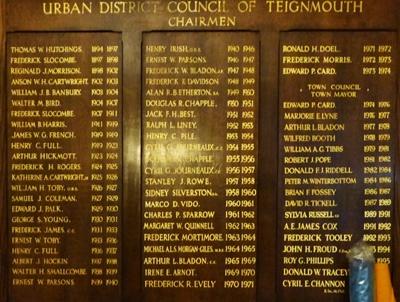
References
http://www.ebooksread.com/authors-eng/winthrop-mackworth-praed/poems-ear/1-poems-ear.shtml
https://www.bartleby.com/360/9/49.html
https://www.britannica.com/biography/Winthrop-Mackworth-Praed
http://www.historyhome.co.uk/people/praed.htm
https://www.janeausten.co.uk/admiral-edward-pellew-the-true-history-of-this-most-novel-captain/
https://en.wikipedia.org/wiki/Philemon_Pownoll#Legacy
https://www.pellew.com/Exmouth/Exmouth%20001/Exmouth%20001.htm
http://www.canonteignfalls.co.uk/history
https://indefatigable1797.wordpress.com/category/edward-pellew/
https://doverhistorian.com/2013/10/08/admiral-edward-pellew-1st-viscount-exmouth-a-local-hero/
https://following-sea.livejournal.com/414736.html#
https://www.ashefamily.info/ashefamily/6813.htm
https://wikivividly.com/wiki/Susan_Pellew#cite_note-:0-1
https://www.findagrave.com/memorial/118239590/edward-pellew
Book on his life: https://books.google.co.uk/books?id=eS4DAAAAYAAJ&pg=PA229&lpg=PA229&dq=obituary+of+1st+Viscount+of+Exmouth&source=bl&ots=jnAvKAYr0C&sig=ACfU3U2Rjx4HsernqnU7VMKbg-66omWIKA&hl=en&sa=X&ved=2ahUKEwjZ5_TqrdXiAhXaDmMBHeVXC7A4ChDoATAEegQICBAB#v=onepage&q=1833&f=false
http://teign-catchment.co.uk/teignmouth/
https://www.wikitree.com/wiki/Pellew-11
http://www.halstedresearch.org.uk/Sir_Lawrence_Halsted.htm
http://www.thedicamillo.com/support/house.html?id=94c4a507-7bf3-4396-a58d-fec19e0e88d8
https://www.wikitree.com/photo/jpg/Frowde-1
http://www.artnet.com/artists/james-leakey/susannah-smith-née-mackworth-praed-seated-in-aa-6c6fBRYNbjF7EL-yBn0sXg2
https://commons.wikimedia.org/w/index.php?curid=20139340
https://books.google.co.uk/books?id=iwtVse6yazQC&pg=PA855&lpg=PA855&dq=Juliana+Shore+(Mackworth-Praed)&source=bl&ots=Ebrkbp2mLx&sig=ACfU3U3PDcdNT32szyOZmHMCCpMZM9TOWA
&hl=en&sa=X&ved=2ahUKEwi8sejSit3iAhVUAWMBHZGkBD4Q6AEwBHoECAkQAQ#v=onepage&q=Juliana%20Shore%20(Mackworth-Praed)&f=false
http://www.exetermemories.co.uk/em/_pubs/royal_clarence.php
https://www.ucl.ac.uk/lbs/person/view/2146638317
https://www.bing.com/images/search?view=detailV2&id=E41B151A1C24DDAB4C940519841D7AD3D72EE883&thid=OIP.yvLaXLqQzhJ6J6tHHIeGPwHaLi&exph=1347&expw=864&q=edward+pellew%2c+1st+viscount+exmouth&selectedindex=142&vt=0&eim=2,6&ccid=yvLaXLqQ&simid=607996466971018869&mediaurl=http%3A%2F%2Fwww.pellew.com%2FExmouth%2FExmouth%2520009%2Fimages%2FPortriature%2520of%2520Edward%2520Pellew%2C%2520Viscount%2520Exmout%2520003.jpg

